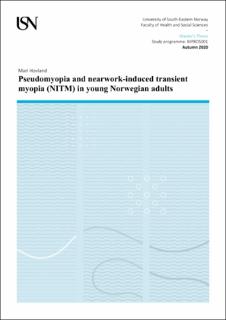| dc.description.abstract | Purpose:
In 2007, the smartphones as we know them today entered the market. The introduction of this digital unit has had a significant impact on our mass media habits and has caused an increase in time spent conducting near work. As near work increases the accommodative response, causing NITM, it is known that excessive viewing time at near can affect the refractive measurements at far. The aim of this study is to investigate the incidence of pseudomyopia and NITM in young healthy myopic Norwegian adults by different noncycloplegic and cycloplegic measurements, and its possible association to recent years change in mass media habits.
Method:
In order to achieve data of habitual and fully relaxed refractive status, measurements of noncycloplegic autorefraction, subjective refraction, retinoscopy and cycloplegic autorefraction were performed and compared on 44 healthy young myopic adults who owe a smartphone. A questionnaire primarily about the participants' use of digital units was also filled out. The age range was 18 to 40 years (mean 29.6 ± 4.7 years).
Results:
When comparing the mean spherical equivalent (SE) of the noncycloplegic autorefraction with (1) the cycloplegic autorefraction and (2) the subjective refraction, the noncycloplegic autorefractor yields more negative values: (1) -0.433 ± 0.372 D; p=0.000; (2) -0.206 ± 0.309 D; p=0.000 respectively. The mean SE of subjective refraction also yields more negative value than the cycloplegic autorefraction: -0.228 ± 0.406 D; p=0.000. Comparison of the mean SE of cycloplegic autorefraction and the retinoscopy presents no significant difference in value: -0.021 ± 0.323 D; p=0.678. 40% of the participants have a noncycloplegic autorefraction value which is more negative equal to 0.50D or more compared to the cycloplegic autorefraction. Within the same measurement comparison, 24.4% have a negative value of more than 0.50D. Participants with a low accommodative lag of 0.50D or less (5) measured with the cross-cylinder test, had a significantly higher mean difference in SE between noncycloplegic and cycloplegic autorefractions than participants with a higher accommodative lag (6): (5) -0.642 ± 0.375 D; (6) -0.317 ± 0.322; p=0.05.
Conclusion:
The present results confirm that noncycloplegic autorefraction yields more negative values than subjective refraction, cycloplegic autorefraction and retinoscopy. There are significant differences between the refractive values of all methods (p < 0.05) except the cycloplegic autorefraction and the noncycloplegic retinoscopy. There was an incidence of 7% pseudomyopia among the participant when comparing the cycloplegic autorefraction with the noncycloplegic subjective refraction (difference > 0.50 D), where 4.5 % would not have been detected without cycloplegic refraction. No significant association between the use of digital units or smartphones and pseudomyopia and NITM was found in this sample of young myopic adults. A larger sample is recommended to confirm these results. | en_US |
